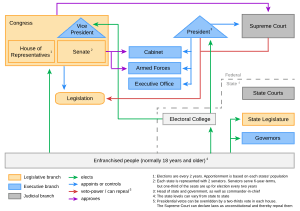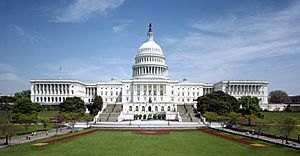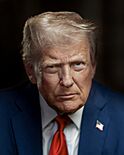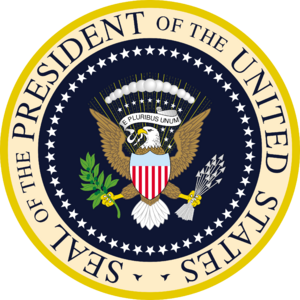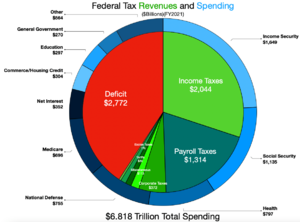Federal government of the United States facts for kids

|
|
| Formation | 1789 |
|---|---|
| Founding document | United States Constitution |
| Jurisdiction | United States |
| Legislative branch | |
| Legislature | Congress |
| Meeting place | Capitol |
| Executive branch | |
| Leader | President |
| Appointer | Electoral College |
| Headquarters | White House |
| Main organ | Cabinet |
| Departments | 15 |
| Judicial branch | |
| Court | Supreme Court |
| Seat | Supreme Court Building |
The federal government of the United States is the national government for the United States. It is often called the U.S. federal government or U.S. government. This government works to serve all people across the country.
The U.S. federal government has three main parts, called branches. These are the legislative, executive, and judicial branches. The U.S. Constitution explains the powers of each branch. It has been in effect since May 4, 1789.
The federal government shares power with the 50 states. This is called federalism. Each state has its own government for its area. The U.S. also recognizes Indigenous tribes as having their own powers. However, they are still under federal rules.
Contents
- What is the U.S. Government Called?
- How the U.S. Government Started
- The Legislative Branch: Making Laws
- The Executive Branch: Carrying Out Laws
- The Judicial Branch: Explaining Laws
- Government Money: The Budget
- Government Workers
- Elections and Voting
- State, Tribal, and Local Governments
- Related Topics
- See also
What is the U.S. Government Called?
The full name of the country is the "United States of America." This name is on money and in legal documents. When people talk about the federal government, they often say "Government of the United States" or "U.S. Government."
Sometimes, people just say "Federal Government" or "U.S. Government." Words like "Federal" or "National" in a group's name usually mean it's part of the federal government. For example, the Federal Bureau of Investigation is a federal agency. Since the government's main offices are in Washington, D.C., people sometimes use "Washington" to mean the federal government.
How the U.S. Government Started
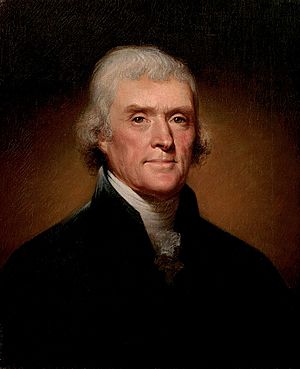
The U.S. government began in the late 1700s. First, the Continental Army was formed to fight the British. This was during the American Revolutionary War, which started in 1775. In July 1776, leaders from the colonies signed the United States Declaration of Independence. This document said the United States was a free country.
In 1783, the colonies won the war against the British. The United States became an independent nation. On March 4, 1789, the colonies approved the Constitution of the United States. This document set up the nation's laws. It was based on ideas like federalism (sharing power) and republicanism (people electing leaders).
The Constitution divides the federal government's power into three branches. It also shares power with state governments and the people. It's a mix of different systems. It is often called a democratic republic or a representative democracy.
People have always debated how much power the federal government should have. Some believe it should have a lot of power. Others think it should have a smaller role. After the American Civil War, the federal government's powers grew a lot.
One key idea of the U.S. Constitution is "checks and balances." This means each branch of government can limit the power of the others. For example, Congress makes laws. But the president can veto (reject) those laws. Congress can then override the veto with enough votes. The president chooses judges for the Supreme Court. But Congress must approve these choices. The Supreme Court can also say that laws passed by Congress are unconstitutional. This means the laws cannot be used.
The Legislative Branch: Making Laws
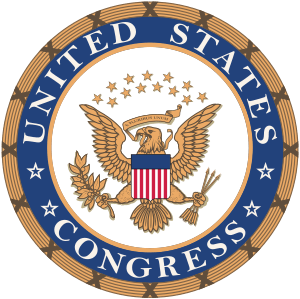
The United States Congress is the part of the government that makes laws. It is made up of two parts: the House of Representatives and the Senate. This is called being bicameral.
How Congress is Set Up
The House of Representatives
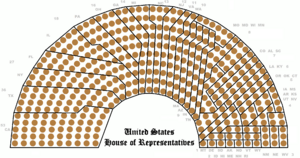
The United States House of Representatives has 435 voting members. Each member represents a specific area in their state, called a congressional district. The number of representatives each state gets depends on its population. This number is updated after each U.S. Census, which happens every ten years. Each representative serves for two years.
To be a representative, a person must be at least 25 years old. They must have been a U.S. citizen for at least seven years. They also must live in the state they represent.
Besides the 435 voting members, there are six non-voting members. These include delegates from Washington, D.C., Guam, the Virgin Islands, American Samoa, and the Northern Mariana Islands. There is also a resident commissioner from Puerto Rico. All members of the House must be elected.
The Senate
The Senate has two senators from each state. This is true no matter how many people live in the state. There are 100 senators in total (2 from each of the 50 states). Each senator serves for six years. About one-third of the Senate seats are up for election every two years.
If a Senate seat becomes empty, the state governor can appoint someone. This person serves until a special election can be held.
Special Powers of Each House
Both the House and Senate have their own special powers. For example, the Senate must approve many important choices made by the president. These include cabinet members, federal judges (like Supreme Court judges), and ambassadors to other countries.
All bills about raising money (taxes) must start in the House of Representatives. For any law to pass, both the House and Senate must approve it. Then, the president must sign it. If the president vetoes a bill, both houses can vote again. If two-thirds of members in both houses agree, the bill becomes law without the president's signature. The powers of Congress are limited to what the Constitution says. Other powers belong to the states and the people.
Removing Federal Officers
Congress can remove the president, federal judges, and other federal officers. This process is called impeachment. The House of Representatives first votes to impeach the official. Then, the Senate holds a trial to decide if the official should be removed. As of 2023, three presidents have been impeached: Andrew Johnson, Bill Clinton, and Donald Trump (twice). None of them were removed from office by the Senate.
How Congress Works
Congress has rules for how it works. These rules created congressional committees. These committees help write laws and investigate national issues. There are many committees and subcommittees. They do most of the detailed work of Congress.
What Congress Can Do
The Constitution gives Congress many powers. These include collecting taxes and printing money. Congress can also create post offices and roads. It can set up federal courts that are below the Supreme Court. Congress has the power to declare war and create armies and a navy. It also makes rules for the military. Congress can make any laws needed to carry out these powers.
Over the years, there have been many arguments about the limits of federal power. These arguments often end up in lawsuits. The United States Supreme Court usually makes the final decision.
Congress Watching Over Others
Congress also has a job called "oversight." This means it watches over the executive branch and other agencies. The goal is to prevent waste and fraud. It also protects civil liberties and makes sure laws are followed. Congress gathers information to make new laws and to inform the public.
This oversight applies to all government departments and agencies. Congress does this in many ways. They hold hearings and ask for reports from the president. The Senate also approves presidential choices and treaties. The House can start impeachment proceedings.
The Executive Branch: Carrying Out Laws
The President
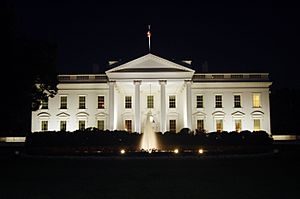
What the President Does
The executive branch is led by the president of the United States. The president is both the head of state (like a national symbol) and the head of government (the chief leader). The Constitution says the president must "take care that the laws be faithfully executed." This means the president must make sure all federal laws are followed. Many presidential actions happen through executive orders.
The president is also the commander-in-chief of the armed forces. This means they are the top leader of the military. The president handles foreign relations and is the country's main diplomat. They can negotiate and sign treaties. However, two-thirds of the Senate must approve treaties.
The president also chooses many government officials. These include ambassadors, judges, and other officers. The Senate must approve these choices. The president can also grant pardons for federal crimes. This means they can forgive someone for a crime or reduce their punishment.
The president also has informal powers. They can greatly influence how laws are made and what policies are followed. The president is usually the leader of their political party.
How the President is Chosen
The president and vice president are usually elected together. They are chosen by the Electoral College. Each state gets a number of electoral votes based on its population. The District of Columbia also gets electoral votes.
A president can also take office through succession. This happens if the current president cannot serve. The Twenty-second Amendment, added in 1951, limits a president to two four-year terms (8 years). In some cases, a president can serve up to 10 years.
Veto Power and Impeachment

When Congress passes a bill, it goes to the president. The president can sign it into law or veto it. If the president vetoes a bill, it goes back to Congress. Congress can override the veto with a two-thirds vote in both houses. This does not happen very often.
The president can be impeached by the House of Representatives. They can be removed from office by the Senate for serious offenses. These include treason or bribery.
The president cannot end Congress. But they can adjourn Congress if the House and Senate cannot agree on when to stop meeting. No president has ever used this power. The president can also call special meetings of Congress for urgent matters.
The Vice President
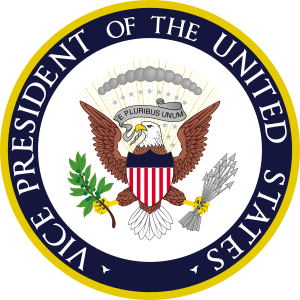
The vice president is the second-highest official in the federal government. The vice president has duties in both the legislative and executive branches. They serve as the president of the Senate. In this role, they can cast a tie-breaking vote if the Senate is evenly split.
The vice president also leads the joint session of Congress when electoral votes are counted. If the president dies, resigns, or is removed, the vice president becomes president. This has happened nine times in U.S. history. The vice president can also become acting president if the president is unable to do their job.
Cabinet and Government Agencies
The Constitution allows for a presidential Cabinet. The Cabinet's job is to advise the president. They also help carry out government programs and laws. The Cabinet includes the vice president and the leaders of 15 executive departments. These departments handle different areas like State, Treasury, Defense, and Education.
The president chooses the heads of these 15 departments. The U.S. Senate must approve them. Once approved, these "Cabinet secretaries" serve as long as the president wants them to.
There are also other important groups that help the president. These are part of the Executive Office of the President (EOP). The EOP includes the White House staff and the National Security Council.
Outside of the Cabinet and EOP, there are many independent agencies. These include the United States Postal Service (USPS), NASA, and the Central Intelligence Agency (CIA). There are also government-owned companies.
The Judicial Branch: Explaining Laws
The judicial branch explains and applies the laws. It does this by hearing and deciding on legal cases.
How the Federal Courts Work

The Constitution created the Supreme Court of the United States. It also allows Congress to create other, lower courts as needed. Federal judges serve for life, as long as they have "good behavior." Their pay cannot be lowered while they are in office. The president appoints all federal judges, and the Senate must approve them.
The Judiciary Act of 1789 set up the basic structure of the federal courts. This includes the Supreme Court, 13 courts of appeals, and 94 district courts. Congress can change or even get rid of federal courts below the Supreme Court.
The U.S. Supreme Court hears cases about the federal government and disputes between states. It also interprets the U.S. Constitution. The Supreme Court can declare laws or actions by any government level unconstitutional. This means the law is no longer valid. This creates a precedent (a rule) for future decisions.
Below the Supreme Court are the U.S. Courts of Appeals. Below them are the U.S. District Courts. District courts are where most federal cases start. They handle both criminal and civil cases.
There are also specialized courts, like bankruptcy courts and the U.S. Tax Court. These courts handle only certain types of cases.
The power of federal courts covers cases related to the Constitution, federal laws, and U.S. treaties. It also includes cases involving ambassadors and disputes where the federal government is a party.
The Constitution protects the independence of judges. This means they can make decisions without fear of losing their jobs or having their pay cut.
State and Federal Courts Working Together
Each state has its own court system. These state courts handle state laws. They also deal with federal law when it applies. The Supreme Court of the United States is the highest court for both federal and state cases. However, state supreme courts are the final authority on their state's laws and constitution.
Federal courts must apply the laws of the state where they are located when hearing state law cases. But they use federal rules for how the case is handled. Together, the laws of the federal and state governments make up U.S. law.
Government Money: The Budget
The government's budget plan usually starts with the president's ideas. The president suggests how much money the government should spend for the next fiscal year. A fiscal year starts on October 1 and ends on September 30 of the next year.
In fiscal year 2018, the federal government spent $4.11 trillion. This was about 20.3% of the country's total economic output (GDP). The government collected $3.33 trillion in taxes. Most of this came from individual income taxes and Social Security taxes.
Government Workers
In fiscal year 2023, the U.S. federal government had about 2,260,000 civilian employees. About 160,000 of these workers were in the District of Columbia. This number does not include people who work for the United States Postal Service.
Elections and Voting
The right to vote, also called suffrage, has changed a lot over time. In the early days of the U.S., only white men who owned land could vote in many places. Senators were chosen by state legislatures, not directly by voters.
Since 1913, with the Seventeenth Amendment, people directly elect both senators and representatives. Today, most U.S. citizens aged 18 and older can vote. This is true regardless of their race, gender, or wealth. One main exception is that people convicted of felonies may not be able to vote in some states.
People living in U.S. territories and Washington, D.C. have limited representation in Congress. They pay federal taxes but their representatives usually cannot vote on laws. However, people in Washington, D.C. have been able to vote in presidential elections since 1961.
State, Tribal, and Local Governments
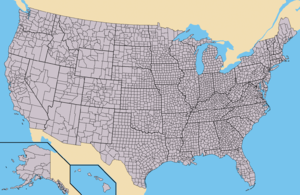
State governments have a big impact on people's daily lives. The Tenth Amendment says that any power not given to the federal government belongs to the states. So, states handle most issues important to people. These include property, crime, health, and education. States usually raise money through taxes or by selling bonds.
Each state has its own constitution, government, and laws. The U.S. Constitution only says that each state must have a "Republican Government." This means there can be big differences in laws between states. The highest elected official in each state is the Governor. Each state also has its own state legislature to make laws. Most states have two parts to their legislature, like Congress. Each state also has its own state court system.
American Indian tribes are seen as "domestic dependent nations." This means they are sovereign governments. They are under federal authority but sometimes outside state government rules. Tribes are encouraged to form their own governments. These often have elected tribal councils or leaders.
Local governments are found within states. These include counties, cities, and special-purpose districts. They make laws for their specific areas. These laws cover things like traffic and local businesses. Counties are parts of a state. In some states, counties have little power. In others, they can collect taxes and have law enforcement. Cities and towns also have their own governments. States can also create special districts for things like school districts or fire departments.
Related Topics
PresidentCourts |
Law
Agencies
|
States and TerritoriesWebsites
|
See also
 In Spanish: Gobierno federal de los Estados Unidos para niños
In Spanish: Gobierno federal de los Estados Unidos para niños


